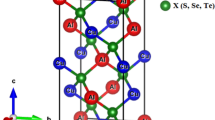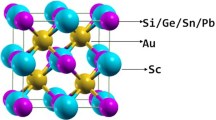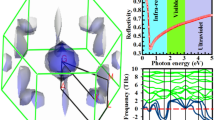Abstract
The world reliance on non-renewable and depleted energy resources has made the search for renewable and sustainable energy more significant. However, a theoretical study is necessary to give a more elaborate investigation of the electronic and optical properties since the role of the heterostructures is still deficient. Furthermore, no first-principles studies have been reported on 2D thermoelectric heterostructures comprising of MgAgAs, 2D-TiC and 2D-Mo2TiC material. Our calculated electronic results show no bandgap induction in the heterostructures compared to pure intermetallic MgAgAs, 2D-TiC and 2D-Mo2TiC material, which favours the separation and transfer of charge carriers and visible-light-driven activity. Based on the analysis of the electronic properties, band structure, projected density of state and spin-polarised contributions from the spin-down and spin-up eigenstates, the Mo2TiC–MgAgAs–Mo2TiC layer was found to have improved conductivity at the infrared region. This makes the electrons move easily from the surface of the thermoelectric material once generated and stored in the heterostructures. The proposed theoretical design offers a new way for the effective and large-scale fabrication of 2D-based thermoelectric materials for application in solar energy conversion and storage.














Similar content being viewed by others
References
Zebarjadi M, Esfarjani K, Dresselhaus M, Ren Z, Chen G (2012) Perspectives on thermoelectrics: from fundamentals to device applications. Energy Environ Sci 5(1):5147–5162
Poon GJ (2001) Electronic and thermoelectric properties of half-Heusler alloys. Semicond Semimetals 70:37–75
Nolas G, Morelli D, Tritt TM (1999) Skutterudites: a phonon-glass-electron crystal approach to advanced thermoelectric energy conversion applications. Annu Rev Mater Sci 29(1):89–116
Jeitschko W (1970) Transition metal stannides with MgAgAs and MnCu2Al type structure. Metall Trans 1(11):3159–3162
Tobola J, Pierre J, Kaprzyk S, Skolozdra R, Kouacou M (1998) Crossover from semiconductor to magnetic metal in semi-Heusler phases as a function of valence electron concentration. J Phys Condens Matter 10(5):1013–1032
Uher C, Yang J, Hu S, Morelli D, Meisner G (1999) Transport properties of pure and doped MNiSn (M = Zr, Hf). Phys Rev B 59(13):8615–8621
Hohl H, Ramirez AP, Goldmann C, Ernst G, Wölfing B, Bucher E (1999) Efficient dopants for ZrNiSn-based thermoelectric materials. J Phys Condens Matter 11(7):1697–1709
Bhattacharya S, Pope A, Littleton R IV, Tritt TM, Ponnambalam V, Xia Y, Poon S (2000) Effect of Sb doping on the thermoelectric properties of Ti-based half-Heusler compounds, TiNiSn1−xSbx. Appl Phys Lett 77(16):2476–2478
Shen Q, Chen L, Goto T, Hirai T, Yang J, Meisner G, Uher C (2001) Effects of partial substitution of Ni by Pd on the thermoelectric properties of ZrNiSn-based half-Heusler compounds. Appl Phys Lett 79(25):4165–4167
Sakurada S, Shutoh N (2005) Effect of Ti substitution on the thermoelectric properties of (Zr, Hf) NiSn half-Heusler compounds. Appl Phys Lett 86(8):082105
Xia Y, Bhattacharya S, Ponnambalam V, Pope A, Poon S, Tritt T (2000) Thermoelectric properties of semimetallic (Zr, Hf) CoSb half-Heusler phases. J Appl Phys 88(4):1952–1955
Lu C, Miao M, Ma Y (2013) Structural evolution of carbon dioxide under high pressure. J Am Chem Soc 135(38):14167–14171
Ding L-P, Shao P, Zhang F-H, Lu C, Ding L, Ning SY, Huang XF (2016) Crystal structures, stabilities, electronic properties, and hardness of MoB2: first-principles calculations. Inorg Chem 55(14):7033–7040
Zhang C, Kuang X, Jin Y, Lu C, Zhou D, Li P, Bao G, Hermann A (2015) Prediction of stable ruthenium silicides from first-principles calculations: stoichiometries, crystal structures, and physical properties. ACS Appl Mater Interfaces 7(48):26776–26782
Kiarii EM, Govender KK, Ndungu PG, Govender PP (2018) Recent advances in titanium dioxide/graphene photocatalyst materials as potentials of energy generation. Bull Mater Sci 41(3):75
Yang J, Li H, Wu T, Zhang W, Chen L, Yang J (2008) Evaluation of half-Heusler compounds as thermoelectric materials based on the calculated electrical transport properties. Adv Funct Mater 18(19):2880–2888
He J, Naghavi SS, Hegde VI, Amsler M, Wolverton C (2018) Designing and discovering a new family of semiconducting quaternary Heusler compounds based on the 18-electron rule. Chem Mater. https://doi.org/10.1021/acs.chemmater.8b01096
Vahabzadeh N-A, Boochani A, Elahi SM, Akbari H (2018) Structural, half-metallic, optical, and thermoelectric study on the Zr2TiX (X = Al, Ga, Ge, Si) Heuslers: by DFT. Silicon 1–11. https://doi.org/10.1007/s12633-018-9939-4
Mehmood N, Ahmad R (2018) Structural, electronic, magnetic and optical investigations of half-Heusler compounds YZSb (Z = Cr, Mn): FP-LAPW method. J Supercond Novel Magn 31(3):879–888
Ahmad R, Mehmood N (2018) A density functional theory investigations of half-Heusler compounds RhVZ (Z = P, As, Sb). J Supercond Novel Magn 31:1577–1586
Novoselov K, Jiang D, Schedin F, Booth T, Khotkevich V, Morozov S, Geim A (2005) Two-dimensional atomic crystals. Proc Natl Acad Sci USA 102(30):10451–10453
Joensen P, Frindt R, Morrison SR (1986) Single-layer MoS2. Mater Res Bull 21(4):457–461
De Padova P, Quaresima C, Ottaviani C, Sheverdyaeva PM, Moras P, Carbone C, Topwal D, Olivieri B, Kara A, Oughaddou H (2010) Evidence of graphene-like electronic signature in silicene nanoribbons. Appl Phys Lett 96(26):261905
Wu W, Lu P, Zhang Z, Guo W (2011) Electronic and magnetic properties and structural stability of BeO sheet and nanoribbons. ACS Appl Mater Interfaces 3(12):4787–4795
Şahin H, Cahangirov S, Topsakal M, Bekaroglu E, Akturk E, Senger RT, Ciraci S (2009) Monolayer honeycomb structures of group-IV elements and III–V binary compounds: first-principles calculations. Phys Rev B 80(15):155453
Du A, Sanvito S, Smith SC (2012) First-principles prediction of metal-free magnetism and intrinsic half-metallicity in graphitic carbon nitride. Phys Rev Lett 108(19):197207
Novoselov K (2007) Graphene: mind the gap. Nat Mater 6(10):720–721
Zhang Z, Liu X, Yakobson BI, Guo W (2012) Two-dimensional tetragonal TiC monolayer sheet and nanoribbons. J Am Chem Soc 134(47):19326–19329
Segall MD, Philip JDL, Probert MJ, Pickard CJ, Hasnip PJ, Clark SJ, Payne MC (2002) First-principles simulation: ideas, illustrations and the CASTEP code. J Phys Condens Matter 14(11):2717–2744
Materials Studio Simulation Environment (2016) Release 2016. Accelrys Software Inc, San Diego
Perdew JP, Burke K, Ernzerhof M (1996) Generalized gradient approximation made simple. Phys Rev Lett 77(18):3865–3868
Song J-W, Yamashita K, Hirao K (2011) Communication: a new hybrid exchange correlation functional for band-gap calculations using a short-range Gaussian attenuation (Gaussian–Perdue–Burke–Ernzerhof). J Chem Phys 135(7):071103
White J, Bird D (1994) Implementation of gradient-corrected exchange-correlation potentials in Car–Parrinello total-energy calculations. Phys Rev B 50(7):4954–4957
Nowotny H, Holub F (1960) Untersuchungen an metallischen Systemen mit Flußspatphasen. Monatsh Chem Verw Teile Anderer Wiss 91(5):877–887
Ordan’yan S (1975) Reactions of rhenium and other refractory metals with some metal-like compounds. Sov Powder Metall 14(2):125–129
Chiarotti G (1995) 1.6 Crystal structures and bulk lattice parameters of materials quoted in the volume. In: Chiarotti G (ed) Interaction of charged particles and atoms with surfaces. Springer, Berlin, pp 21–26
Docherty R, Clydesdale G, Roberts K, Bennema P (1991) Application of Bravais–Friedel–Donnay–Harker, attachment energy and Ising models to predicting and understanding the morphology of molecular crystals. J Phys D Appl Phys 24(2):89–99
Becke AD, Edgecombe KE (1990) A simple measure of electron localization in atomic and molecular systems. J Chem Phys 92(9):5397–5403
Kohout M, Savin A (1997) Influence of core-valence separation of electron localization function. J Comput Chem 18(12):1431–1439
Chesnut D (2001) The use of parameter ratios to characterize the formal order of chemical bonds. Chem Phys 271(1-2):9–16
Mott NF, Jones H (1958) The theory of the properties of metals and alloys. Dover Publications Inc, New York
Nicolaou MC (2009) Thermoelectric figure of merit of degenerate and nondegenerate semiconductors. Northeastern University, Boston
Sootsman JR, Chung DY, Kanatzidis MG (2009) New and old concepts in thermoelectric materials. Angew Chem Int Ed 48(46):8616–8639
Hicks L, Dresselhaus M (1993) Effect of quantum-well structures on the thermoelectric figure of merit. Phys Rev B 47(19):12727–12731
Larson P, Mahanti S, Kanatzidis MG (2000) Electronic structure and transport of Bi2Te3 and BaBiTe3. Phys Rev B 61(12):8162–8171
Grundmann M (2010) Kramers-Kronig relations. In: Rhodes WT, Stanley HE, Needs R (eds) The physics of semiconductors: an introduction including nanophysics and applications. Springer, Berlin, Heidelberg, pp 775–776
Ziman JM (1960) Electrons and phonons: the theory of transport phenomena in solids. Oxford University Press, New York
Collett E (2005) Field guide to polarization, vol 15. SPIE Press, Bellingham
Chen X, Shen S, Guo L, Mao SS (2010) Semiconductor-based photocatalytic hydrogen generation. Chem Rev 110(11):6503–6570
Nolan M, Elliott SD (2006) The p-type conduction mechanism in Cu2O: a first principles study. Phys Chem Chem Phys 8(45):5350–5358
Zhang H, Liu L, Zhou Z (2012) First-principles studies on facet-dependent photocatalytic properties of bismuth oxyhalides (BiOXs). RSC Adv 2(24):9224–9229
Zhang J, Zhou P, Liu J, Yu J (2014) New understanding of the difference of photocatalytic activity among anatase, rutile and brookite TiO2. Phys Chem Chem Phys 16(38):20382–20386
Li M, Zhang J, Dang W, Cushing SK, Guo D, Wu N, Yin P (2013) Photocatalytic hydrogen generation enhanced by band gap narrowing and improved charge carrier mobility in AgTaO3 by compensated co-doping. Phys Chem Chem Phys 15(38):16220–16226
Dong M, Zhang J, Yu J (2015) Effect of effective mass and spontaneous polarization on photocatalytic activity of wurtzite and zinc-blende ZnS. APL Mater 3(10):104404
Zhang H, Liu L, Zhou Z (2012) Towards better photocatalysts: first-principles studies of the alloying effects on the photocatalytic activities of bismuth oxyhalides under visible light. Phys Chem Chem Phys 14(3):1286–1292
Opoku F, Govender KK, van Sittert CGCE, Govender PP (2017) Understanding the mechanism of enhanced charge separation and visible light photocatalytic activity of modified wurtzite ZnO with nanoclusters of ZnS and graphene oxide: from a hybrid density functional study. New J Chem 41:8140–8155
Yuan K, Chen L, Li F, Chen Y (2014) Nanostructured hybrid ZnO@CdS nanowalls grown in situ for inverted polymer solar cells. J Mater Chem C 2(6):1018–1027
Louis E, San-Fabián E, Díaz-García MA, Chiappe G, Vergés JA (2017) Are electron affinity and ionization potential intrinsic parameters to predict the electron or hole acceptor character of amorphous molecular materials? J Phys Chem Lett 8(11):2445–2449
Opoku F, Govender KK, van Sittert CGCE, Govender PP (2018) Insights into the photocatalytic mechanism of mediator-free direct Z-scheme g-C3N4/Bi2MoO6(010) and g-C3N4/Bi2WO6(010) heterostructures: A hybrid density functional theory study. Appl Surf Sci 427:487–498
Luo C-Y, Huang W-Q, Hu W, Peng P, Huang G-F (2016) Non-covalent functionalization of WS2 monolayer with small fullerenes: tuning electronic properties and photoactivity. Dalton Trans 45(34):13383–13391
Acknowledgements
The authors would like to acknowledge the financial contributions from the Faculty of Science: University of Johannesburg, South Africa: Centre for Nanomaterials Science Research, Department of Applied Chemistry and the National Research Foundation (TTK14052167682). The authors are also grateful to the Centre for High-Performance Computing (CHPC) for computational resources provided.
Author information
Authors and Affiliations
Corresponding author
Ethics declarations
Conflict of interest
The authors declare that they have no conflict of interest.
Rights and permissions
About this article
Cite this article
Kiarii, E.M., Govender, K.K., Mamo, M.A. et al. A first-principles study of half-Heusler intermetallic compound MgAgAs with 2D-TiC/2D-Mo2TiC composite material. Theor Chem Acc 137, 136 (2018). https://doi.org/10.1007/s00214-018-2337-6
Received:
Accepted:
Published:
DOI: https://doi.org/10.1007/s00214-018-2337-6




